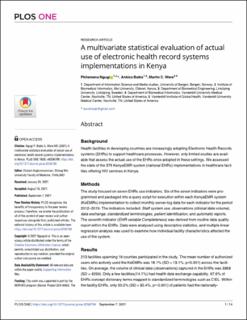| dc.contributor.author | Ngugi, Philomena Njeri | |
| dc.contributor.author | Babic, Ankica | |
| dc.contributor.author | Were, Martin C. | |
| dc.date.accessioned | 2022-01-19T12:24:43Z | |
| dc.date.available | 2022-01-19T12:24:43Z | |
| dc.date.created | 2021-09-08T17:50:01Z | |
| dc.date.issued | 2021 | |
| dc.identifier.issn | 1932-6203 | |
| dc.identifier.uri | https://hdl.handle.net/11250/2838251 | |
| dc.description.abstract | Background Health facilities in developing countries are increasingly adopting Electronic Health Records systems (EHRs) to support healthcare processes. However, only limited studies are available that assess the actual use of the EHRs once adopted in these settings. We assessed the state of the 376 KenyaEMR system (national EHRs) implementations in healthcare facilities offering HIV services in Kenya. Methods The study focused on seven EHRs use indicators. Six of the seven indicators were programmed and packaged into a query script for execution within each KenyaEMR system (KeEMRs) implementation to collect monthly server-log data for each indicator for the period 2012–2019. The indicators included: Staff system use, observations (clinical data volume), data exchange, standardized terminologies, patient identification, and automatic reports. The seventh indicator (EHR variable Completeness) was derived from routine data quality report within the EHRs. Data were analysed using descriptive statistics, and multiple linear regression analysis was used to examine how individual facility characteristics affected the use of the system. Results 213 facilities spanning 19 counties participated in the study. The mean number of authorized users who actively used the KeEMRs was 18.1% (SD = 13.1%, p<0.001) across the facilities. On average, the volume of clinical data (observations) captured in the EHRs was 3363 (SD = 4259). Only a few facilities(14.1%) had health data exchange capability. 97.6% of EHRs concept dictionary terms mapped to standardized terminologies such as CIEL. Within the facility EHRs, only 50.5% (SD = 35.4%, p< 0.001) of patients had the nationally-endorsed patient identifier number recorded. Multiple regression analysis indicated the need for improvement on the mode of EHRs use of implementation. Conclusion The standard EHRs use indicators can effectively measure EHRs use and consequently determine success of the EHRs implementations. The results suggest that most of the EHRs use areas assessed need improvement, especially in relation to active usage of the system and data exchange readiness. | en_US |
| dc.language.iso | eng | en_US |
| dc.publisher | PLOS | en_US |
| dc.rights | Navngivelse 4.0 Internasjonal | * |
| dc.rights.uri | http://creativecommons.org/licenses/by/4.0/deed.no | * |
| dc.title | A multivariate statistical evaluation of actual use of electronic health record systems implementations in Kenya | en_US |
| dc.type | Journal article | en_US |
| dc.type | Peer reviewed | en_US |
| dc.description.version | publishedVersion | en_US |
| dc.rights.holder | Copyright 2021 The Author(s) | en_US |
| dc.source.articlenumber | e0256799 | en_US |
| cristin.ispublished | true | |
| cristin.fulltext | original | |
| cristin.qualitycode | 1 | |
| dc.identifier.doi | 10.1371/journal.pone.0256799 | |
| dc.identifier.cristin | 1932587 | |
| dc.source.journal | PLOS ONE | en_US |
| dc.relation.project | NORHED: Project QZA-0484 | en_US |
| dc.identifier.citation | PLOS ONE. 2021, 16(9): e0256799. | en_US |
| dc.source.volume | 16 | en_US |
| dc.source.issue | 9 | en_US |

